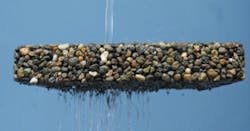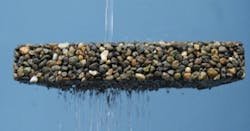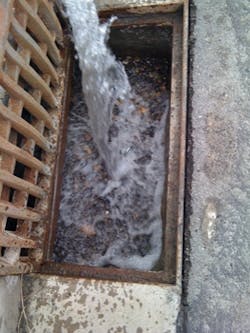Pervious Pavers Provide New Solution for Stormwater Management
Pervious pavers can function as a stand-alone stormwater control measure (SCM) in drainage applications or used in conjunction with other control measures to allow stormwater to infiltrate or discharge to surface waters. One company, Xeripave, LLC (Vancouver, WA), has created super pervious pavers that are being used in city and county stormwater management plans.
By Peter Blundell
With today’s green initiative toward Low Impact Development (LID) and NPDES (National Pollution Discharge Elimination System) requirements, government and commercial entities are looking to implement stormwater control measures (SCM) that meet LID goals. One cost-effective solution is the use of super pervious pavers that can function as a stand-alone SCM in drainage applications or used in conjunction with other control measures to allow stormwater to infiltrate or discharge to surface waters.
One company, Xeripave, LLC (Vancouver, WA), has created super pervious pavers that are being used in city and county stormwater management plans. The pavers have a flow-through rate exceeding 5,000 inches per hour and are suitable for a large number of engineered applications.
Historically, applications use pavers with pervious joints, porous asphalt or concrete to provide runoff infiltration to underlying porous, open-graded fill storage and native soils. Though effective, these options can be expensive, problematic and difficult to maintain.
However, due to the super porous nature of the Xeripave pavers, stormwater sheet flow from parking lots, roadways, and other impervious surfaces can be captured and transported to the underlying base of rock, which stores the volume of water and allows for slower infiltration into the underlying soils. For example, sheet flow from driveways and parking lots can be captured in a “strip drain” configuration, or runoff from sidewalks can be used to recharge water to street trees.
Washoe County Pilot Study
One of the more specifically engineered pervious paver applications was developed for the Washoe County (NV) Health Department. The County performed a two-year pilot program study on the use of pervious paver filtration trays installed inside catch basins, a design that allows stormwater to flow through while simultaneously catching 100 percent of particles larger than 600 microns. As an emergency precaution, the design includes an overflow valve in case of flooding.
The county found that the trays in the catch basins provided more than just stormwater filtration: they reduced the mosquito population by preventing access to standing, stagnant water at the bottom of the stormwater basin, a common mosquito breeding ground. As a result, these trays have become mandatory in new infrastructure construction projects not maintained by the county.
In addition, Washoe County Health Department made it mandatory for local school districts to install the filtration trays in catch basins surrounding the schools to reduce insect vectors. Jim Shaffer, Planner with the Vector-Borne Diseases Environmental Health Division in Washoe County, stated, “Catch basins are like incubators, producing mosquitoes every seven days during the summer months. Using these tray systems prevents mosquitoes from laying eggs and reduces the amount of pesticides that would otherwise be needed. It is becoming the hydrology standard in the County.”
After the pilot program for Washoe County was completed, the Nevada Department of Environmental Protection (NDEP) awarded a grant to study the costs and benefits of 100 storm drains retrofitted with the Xeripave Tray System. The objective was to restore the county’s optimal cleaning schedule, which had been adversely affected by economic cutbacks that had forced a reduction of maintenance crews and equipment.
The study looked at the amount of stormwater sediment captured, water usage during maintenance, and the amount of basin cleanings per shift of county maintenance crews. Historically, during the maintenance cleaning, a large amount of time is spent collecting and hauling wet waste material, considered a regulated waste, to dump sites where the water is evaporated and/or run into a sand-oil separator. Reducing or eliminating the amount of water collected per cleaning reduces the number of dumping trips and the handling and drying time of the residuals, both of which are a substantial part of the maintenance costs.
TC Twitchell, Assistant Project Manager to the NDEP grant, stated, “We are working closely with maintenance crews in the field to come up with a design that is safe and practical. [The tray system] is anticipated to have a 75 percent water reduction and a 50 percent increase in drainage inlet (DI) cleanings per shift.”
Twitchell noted that maintenance departments are finding that drainage inlets using the tray systems are easier to maintain, requiring only a periodic cleaning with a vacuum truck. “Washoe County is standing behind these pervious pavers and tray systems, letting other public officials know how they’ve been helping them meet stormwater management needs.”
Shortly after Washoe County mandated the use of the filtration trays, other cities and counties began pilot studies on using the tray application to help capture urban pollutants found in stormwater runoff. The City of Reno and City of Sparks are two examples. The City of Reno has retrofitted six storm drains, while the City of Sparks has retrofitted four. Both cities will be analyzing the effectiveness of the filtration trays for a full season.
Communities in other states are taking interest as well. Butte County, CA, is considering a pilot program after numerous protests on chemical spraying in the drainage systems to control mosquitoes. The county’s goal is to completely eliminate the use of chemicals to control mosquitoes in stormwater catch basins.
First Flush Applications
The filtration trays aren’t the only pervious paver application attracting the attention of government agencies. Washoe County and the City of Reno are investigating the use of pervious pavers on retention structures to manage the first flush of stormwater. First flush occurs during the first 0.6 inch of rainfall and carries the highest concentration of pollutants. In this type of application, the pavers are placed on top of stormwater vaults to allow the water to flow through. The stormwater is then filtered and infiltrated back into the aquifer.
Whether as a stand-alone solution or in conjunction with other control measures, pervious pavers are taking their place among accepted BMPs to control stormwater runoff. They provide a cost-effective solution that’s in line with today’s LID objectives and NPDES requirements.
WW
About the Author: Peter Blundell is the President of Xeripave, LLC. He has a degree in Mechanical Engineering from the University of British Columbia. In 1990, he started his own company specializing in manufacturing products for the water pump and water park industries. In 1992, his business diversified into manufacturing green building products for the hardscape industry.
More WaterWorld Current Issue Articles
More WaterWorld Archives Issue Articles



